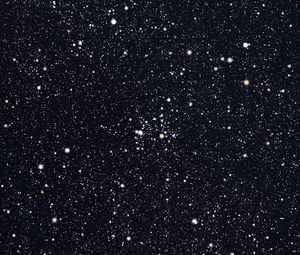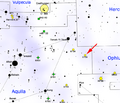Astronomy:NGC 6709
| NGC 6709 | |
|---|---|
 | |
| Observation data (J2000 epoch) | |
| Constellation | Aquila |
| Right ascension | 18h 51m 20.6s[1] |
| Declination | +10° 20′ 02″[1] |
| Distance | 3,510 ly (1,075 pc)[2] |
| Apparent magnitude (V) | 6.7 |
| Apparent dimensions (V) | 13' |
| Physical characteristics | |
| Radius | 26 ly[2] (tidal) |
| Estimated age | 141 Myr[2] |
| Other designations | NGC 6709, Cr 392[3] |
NGC 6709 is an open cluster of stars in the equatorial constellation of Aquila, some 5° to the southwest of the star Zeta Aquilae.[4] It is situated toward the center of the galaxy[5] at a distance of 3,510 light-years.[2]
This cluster has a Trumpler class of IV 2 m, and is considered moderately rich[5] with 305[6] member stars. It is around 141[2] million years old; about the same as the Pleiades.[6] The core radius of NGC 6709 is 2.2 ly (0.68 pc) and the tidal radius 26.4 ly (8.08 pc).[2] It contains two Be stars and one of them is a shell star. There is one candidate red giant member.[5]
On the evening of November 13, 1984, David H. Levy discovered his first comet less than a degree from this cluster.[7]
Gallery
-
Location diagram of NGC 6709
References
- ↑ 1.0 1.1 Cantat-Gaudin, T.; Anders, F. (January 2020). "Clusters and mirages: cataloguing stellar aggregates in the Milky Way". Astronomy & Astrophysics 633: 22. doi:10.1051/0004-6361/201936691. A99. Bibcode: 2020A&A...633A..99C.
- ↑ 2.0 2.1 2.2 2.3 2.4 2.5 Dib, Sami et al. (January 2018). "Structure and mass segregation in Galactic stellar clusters". Monthly Notices of the Royal Astronomical Society 473 (1): 849–859. doi:10.1093/mnras/stx2413. Bibcode: 2018MNRAS.473..849D.
- ↑ "NGC 6709". SIMBAD. Centre de données astronomiques de Strasbourg. http://simbad.u-strasbg.fr/simbad/sim-basic?Ident=NGC+6709.
- ↑ Crossen, Craig; Rhemann, Gerald (2012). Sky Vistas: Astronomy for Binoculars and Richest-Field Telescopes. Springer Vienna. p. 58. ISBN 9783709106266. https://books.google.com/books?id=3vELBwAAQBAJ&pg=PA58.
- ↑ 5.0 5.1 5.2 Subramaniam, Annapurni; Sagar, Ram (February 1999). "Multicolor CCD Photometry and Stellar Evolutionary Analysis of NGC 1907, NGC 1912, NGC 2383, NGC 2384, and NGC 6709 Using Synthetic Color-Magnitude Diagrams". The Astronomical Journal 117 (2): 937–961. doi:10.1086/300716. Bibcode: 1999AJ....117..937S.
- ↑ 6.0 6.1 Cole-Kodikara, Elizabeth M.; Barnes, Sydney; Weingrill, Jörg; Fritzewski, Dario; Gruner, David (March 2021). "NGC 6709: A Faint Zero-Age Main Sequence Open Cluster". The 20.5th Cambridge Workshop on Cool Stars, Stellar Systems, and the Sun (CS20.5), virtually anywhere, March 2–4, 2021. doi:10.5281/zenodo.4565515. 175. Bibcode: 2021csss.confE.175C.
- ↑ Levy, David H. (2003). David Levy's Guide to Observing and Discovering Comets. Cambridge University Press. p. 52.
External links
- NGC 6709 on WikiSky: DSS2, SDSS, GALEX, IRAS, Hydrogen α, X-Ray, Astrophoto, Sky Map, Articles and images
- webda
Coordinates: ![]() 18h 51m 18s, +10° 19′ 00″
18h 51m 18s, +10° 19′ 00″
 |


